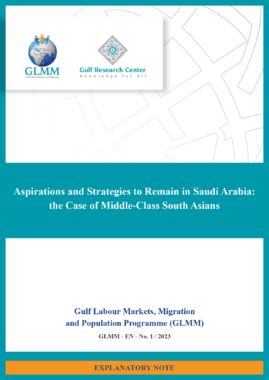Context
All Gulf Cooperation Council (GCC) members share as a common feature a high dependency on a foreign workforce and a persistently high and, in most cases, growing proportion of non-nationals in the resident population. The GCC’s uniqueness, however, lies in the high level of immigration as well as in the persistence over time of a high proportion of non-citizens because of numerous factors, including the limited channels for naturalizing foreign nationals. As of 2020, foreign population ranged between an estimated 39% of the total population in Saudi Arabia and Oman, and 88% in Qatar.
At the same time, migration to these countries has common features with migration to other countries in the world regarding the causes, patterns and consequences. As elsewhere, family reunion boosted the number of non-working foreign nationals, while the emergence of a second generation born in the GCC to foreign nationals can be witnessed. Governments have only recently started to acknowledge this fact. Thus, the GCC countries are also subject to demographic, economic, social, political, and legal dynamics comparable to those found in other countries that experience(d) significant immigration.
During the 2010s, the annual foreign population growth in the six GCC countries was ranging from 3.2% in Saudi Arabia (2015) to 7.3% in Qatar (average 2010-2015), faster than the national population which grew yearly between 2.3% in Kuwait (2016) and 3.1% in Oman (2016).
Since 2015-2017, however, foreign, and total population growth rates started levelling off. Bahrain and Oman even witnessed negative growth rates in their foreign populations. In 2020, as the region was hit by the Covid-19 pandemic, the numbers of expatriates decreased further, almost everywhere in the region. Restrictions of entries, fluctuations of oil prices and economic downturn combined with ambitious socio-economic reforms and labour nationalisation policies aiming to increase the participation of nationals in the workforce. As oil prices reach new heights in the last quarter of 2021, how do foreign migrants and workers cope with the rapidly changing circumstances in the region? How does this context influence migration dynamics, the structure of migrant populations and their integration into local societies in the region? What future can be foreseen for migration to the Gulf states?
While the production of knowledge concerning the two other major destinations of global migration – North America and Europe – is enormous, knowledge production on GCC migration, while recently increasing, is still in a state of infancy in terms of availability of reliable and comparable data, and of general, comparative and case studies as well as policy papers. GLMM programme contributors’ aim is to help bridging this knowledge gap, to the benefit of academics and students, media persons, legal organisations, and policy makers, in the Gulf and elsewhere.


